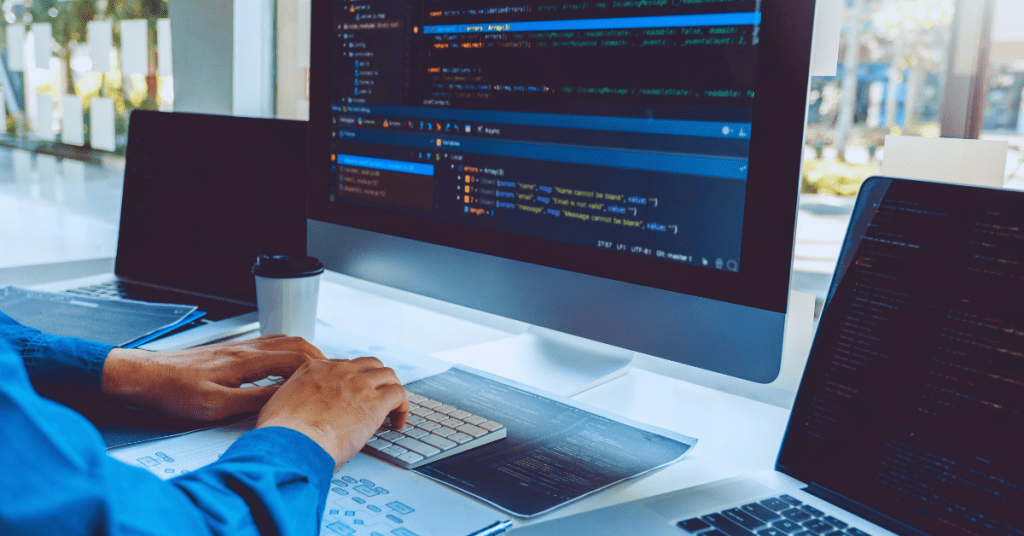Mastering Concurrency in Java for Effective Parallel Programming
Industry Trends & Innovation
Read Time: 15 mins

Introduction to Concurrency in Java
Concurrency plays a big role in most modern software development, allowing applications to take care of multiple different tasks at once while maximizing resource efficiency. As a flexible and powerful programming language, Java has advanced its own concurrency features to help developers build more scalable, high-performance applications. This article dives into concurrency techniques and best practices in Java, offering valuable insights to address complex concurrency issues and optimize their applications effectively.What is Concurrency?
Concurrency is a key feature utilized by leading Java development companies, allowing programs to run multiple tasks at the same time. This approach helps optimize the use of system resources, ultimately enhancing the performance and responsiveness of applications. Java provides built-in support for concurrency through various concepts, interfaces, and classes designed for multithreading, including Thread, Runnable, Callable, Future, and ExecutorService. The java.util.concurrent package further expands on these capabilities. Since these concurrency tools are part of Java’s standard library, the implementation is consistent across different Java frameworks.Benefits of Concurrency
Concurrency offers an excellent approach to developing high-performance modern applications for several reasons.
Enhanced Performance
Concurrency enables the breakdown of complex, time-intensive tasks into smaller, parallelized components, leading to enhanced performance. This leverages today’s multi-core processors, allowing applications to run significantly faster.Efficient Resource Utilization
With concurrency, system resources are utilized more efficiently. By adopting asynchronous I/O operations, the system can prevent thread blocking, allowing other tasks to run simultaneously. This maximizes system efficiency and resource usage.Increased Responsiveness
In interactive applications, concurrency improves user experience by ensuring the application remains responsive. While one thread handles heavy computations, another can simultaneously manage user inputs or update the interface.Easier Modeling
For scenarios like simulations or game engines, concurrency mirrors the inherent parallelism of the problem domain. This approach not only improves performance but also simplifies the design and implementation of such systems.Comprehensive Concurrency API
Java provides a robust concurrency API with features like thread pools, concurrent collections, and atomic variables. These tools simplify the process of writing concurrent code while addressing common concurrency challenges effectively.Challenges in Concurrency
Remember that beginners aren't well-adapted for concurrent programming. Adding complexity to your applications, this feature presents a distinct set of challenges including synchronization management, deadlock prevention, and thread safety guarantee. Before making a decision to delve into concurrency, it is important to keep a few things in mind.- Growing complexity: Creating programs that run concurrently is typically more difficult and requires more time than developing applications that run only one thread. Developers need to grasp ideas such as synchronization, memory visibility, atomic operations, and thread communication.
- Debugging Challenges: Challenges in debugging arise due to the uncertainty of concurrent program behavior. Race conditions or deadlocks can sometimes arise unexpectedly, making them difficult to reproduce and resolve.
- Increased chance of mistakes: Improperly managing concurrency may result in significant problems such as race conditions, deadlocks, and thread interference. Identifying and resolving these errors can pose a challenge.
- Contention of Resources: Resource contention can occur in concurrent applications due to poor design, causing multiple threads to compete for the same resource and resulting in decreased performance.
- Overhead Expense: Managing overhead costs involves allocation of extra CPU and memory resources for handling threads. If not managed correctly, this could lead to decreased efficiency or depletion of resources.
- Difficult testing: The testing of concurrent programs can be especially challenging because of the unpredictable and non-deterministic execution of threads.
Java Concurrency Basics

Threads and Runnable Interface
Threads can be created in a few ways, and here we'll demonstrate how to create the same thread using different approaches.Using Inheritance From the Thread Class
One method to create a thread is by inheriting from the Thread class. In this approach, you simply override the run() method in the thread class. This method is always automatically called when the thread starts. If you want to create and initiate a thread, the best way is to make an instance of the class and then invoke the start() method. Calling the the run() method directly to start the thread is a common mistake. Now this may seem like it works since the code runs as expected but it doesn’t actually start a new thread. Instead, it executes the run() method on the main thread. The right way to start a new thread, is to use the start() method. By calling thread.run() instead of thread.start() in your code, you can observe this behavior. You'll notice that "main" is printed in the console, indicating that no new thread is created, and the task is executed in the main thread. For further details on the Thread class, consult the official documentation.Using the Runnable Interface
Implementing the Runnable interface is another approach to creating a thread. You'll need to override the run() method, where you'll define the tasks for the thread to execute, similar to the previous method. Both this method and inheriting from the Thread class offer identical performance. However, the advantage of using the Runnable interface is that it allows you to extend another class, as Java only supports single inheritance. Additionally, using runnables makes it easier to manage thread pools.The `Executor` Framework
Starting a thread requires resources, and threads are terminated once their task is completed. In applications that handle numerous tasks, it's more efficient to queue the tasks rather than continuously creating new threads. Wouldn't it be ideal to reuse threads while also capping the total number of threads created? The ExecutorService class provides this capability, allowing you to create a fixed number of threads that can handle multiple tasks. By managing a set number of threads, you gain greater control over the application’s performance.Race Conditions in Java
When the behavior of a program depends on the timing or interleaving of multiple threads or processes, race conditions occur. Let’s explore this with an example. We have an Increment class that holds a variable count and a method to increment it. In the RaceConditionsExample, we start a thousand threads, each calling the increment() method. After all threads finish execution, the program prints the value of the count variable. You'll notice that the final value of count is sometimes less than 1,000 if you run the program many times. This happens because, in some cases, the order of execution between two threads—let’s call them Thread-x and Thread-y—varies. The threads may perform the read and write operations in a different sequence. For instance, both threads might read the value of count before either has a chance to update it. As a result, the final value of count is 1 instead of 2, because both threads read the same initial value before incrementing it. This is an example of a race condition, more specifically a "read-modify-write" race condition.Synchronization in Java
We explored race conditions and how they occur In the previous section. To prevent race conditions, we need to synchronize tasks. We'll examine a few methods to synchronize your processes across multiple threads in this section.
Locks
You may be wanting a specific task to be carried out by only one thread at a time. But how can you ensure that only one thread is executing it? One solution is to use locks. A lock object is unique in that only one thread can “acquire” it at a time. Before executing a task, a thread attempts to acquire the lock. It proceeds with the task if successful; once done, it releases the lock. Another thread must wait until the first thread releases it if trying to acquire the same lock. The ReentrantLock class is an example of implementation of the Lock interface. When a thread calls the lock() method, it attempts to gain control of the lock. The thread performs the task if it succeeds, otherwise, it is blocked until the lock is available.- isLocked(): This method returns true if the lock is currently held by any thread, otherwise false.
- tryLock(): This method attempts to acquire the lock without blocking. It returns true if it succeeds; otherwise, it returns false.
- unlock(): This method releases the lock, allowing other threads to acquire it.
ReadWriteLock
When dealing with shared resources, you often want two things:- As long as no thread is writing to it, multiple threads should be able to read the resource simultaneously.
- It should only proceed when no threads are reading or writing and only one thread should be able to write to the resource at a time.
Synchronized Blocks and Methods
In Java, synchronized blocks restrict multiple threads from executing the same code simultaneously, offering an easy way to coordinate thread activities. Passing a reference object lets you create a synchronized block. This helps maintain synchronization among threads working with the same instance. You could also use the synchronized keyword to synchronize an entire method. This allows only one thread to run it at a time.Deadlocks
When two or more threads are stuck because they are waiting for the other to release a resource or perform a task, deadlock occurs. This results in both threads being blocked indefinitely. To prevent deadlocks, consider the following tips:- Enforce an acquisition order: Establish a strict order for acquiring resources. All threads should follow the same order when requesting resources.
- Avoid nested locks: The deadlock occurs because each thread waits for the other to release a lock in the example above. Avoid nesting locks or synchronized blocks to reduce this risk.
- Limit resource acquisition: Threads should avoid holding multiple resources at the same time. If a thread requires a second resource, it should release the first before requesting the second.
- Set timeouts: Set a timeout when attempting to acquire a lock. It should release any held locks and retry later, reducing the chance of a deadlock, if the thread cannot acquire the lock within a specified time.
Java Concurrent Collections in Java
The Java platform includes several concurrent collections in the java.util.concurrent package, designed for thread safety and concurrent access.ConcurrentHashMap
ConcurrentHashMap is a thread-safe alternative to HashMap. It includes methods that support atomic updates and retrievals, which help prevent race conditions. For example, methods like putIfAbsent(), remove(), and replace() ensure that these operations are carried out atomically.CopyOnWriteArrayList
Imagine a situation where one thread is reading or iterating over an array list while another thread is modifying it. This can lead to inconsistencies during reads or even result in a ConcurrentModificationException. CopyOnWriteArrayList addresses this issue by making a copy of the entire array every time a modification occurs. This allows iteration over the original version while modifications are applied to the new copy. Although CopyOnWriteArrayList provides thread safety, it comes at a cost. Modifications such as adding or removing elements are resource-intensive because they involve creating a fresh copy of the array. As a result, this collection is best suited for use cases where reading operations are far more frequent than writes.Java Concurrency Best Practices

Ensure Thread Safety
Ensuring thread safety is a fundamental aspect of concurrent programming. One of the best practices to achieve this is by making objects immutable, which helps avoid synchronization issues. Additionally, using atomic variables and operations is crucial to maintain thread safety in multithreaded environments.Avoid Common Pitfalls
Avoid common pitfalls when using concurrency is important. Employing strategies like lock ordering, lock timeouts, and deadlock detection can help prevent deadlock. To prevent race conditions, developers should rely on synchronization, locks, or atomic variables to ensure proper thread execution.Optimize Performance
Optimizing performance in concurrent applications requires profiling and tuning. Developers can handle this effectively by using profiling tools to identify bottlenecks. The right concurrency constructs for the specific needs of the application also plays a key role in ensuring smooth and efficient operation.Use Immutable Classes
Another widely recommended practice in Java multithreading is to prefer immutable classes. Immutable classes, such as String, Integer, and other wrapper classes, simplify writing concurrent code by eliminating concerns over state management. This also reduces the need for synchronization, making the code cleaner and easier to manage.Minimize Shared Resources
Minimizing shared resources is another key aspect of building robust multithreaded applications. Reducing the use of shared resources helps decrease contention and lowers synchronization overhead, leading to better performance.Use High Level Utilities
Java has higher-level concurrency utilities that offer an abstract approach to the implementation of concurrency patterns. Using these utilities, developers reduce the complexity of their code and improve maintainability.Test Thoroughly
Thorough testing is essential for reliability of multithreaded applications. Unit tests, integration tests, and stress tests should be used to validate concurrency logic and identify potential issues, ensuring that the application performs reliably under various conditions.Java Concurrency Advanced Techniques

